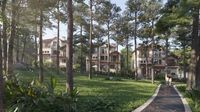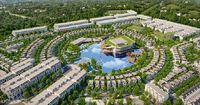The real estate market in the suburbs of Hanoi has seen a significant surge in land prices, with increases ranging from 30% to an astonishing 80% in some areas during the first two months of 2025. This trend, highlighted by a report from Batdongsan.com.vn, indicates that regions like Quoc Oai have experienced a notable increase of 74%. While this upward trajectory in land prices reflects a robust market, it has also raised concerns about the sustainability of these increases, especially as interest in land plots has not kept pace.
According to Nguyen Quoc Anh, Deputy General Director of Batdongsan.com.vn, the continuous rise in land prices over recent years has led many investors and potential buyers to adopt a wait-and-see approach. “Many are observing the market closely before making any decisions,” he stated. This cautious sentiment is further compounded by recent news regarding the planned merger of several provinces, which has shifted the focus of speculators from urban areas near the capital to more provincial opportunities.
The anticipated mergers have sparked a notable increase in interest for real estate in several localities. For instance, data from Batdongsan.com.vn reveals that interest in areas such as Nhon Trach surged by 41%, while Thuan An and Di An in Binh Duong saw increases of 26% and 23%, respectively. Although prices in Nhon Trach and Ba Ria Vung Tau have risen by 20-30%, nearing the peaks seen in 2022, this has led to questions about whether the market is experiencing an unsustainable spike.
Additionally, the Market Research Team of the Vietnam Real Estate Brokers Association (VARS) reported that in various localities across Vietnam, land prices have been pushed up by as much as 20% following the announcement of potential provincial mergers. However, the volume of transactions has only noticeably increased in those areas predicted to be central to the merger, where real estate prices remain relatively low.
VARS emphasized that such price fluctuations are not new to the Vietnamese real estate market. Historical trends indicate that whenever new planning information emerges, land prices in related areas tend to rise sharply in the short term. This phenomenon is largely driven by the fear of missing out (FOMO) among investors, who feel an urgency to act quickly, believing that such changes will inevitably lead to economic and social development, along with rising property values.
In recent years, there has been a marked shift in housing demand, with many opting to move from the core of Hanoi to well-developed satellite cities and provinces. According to Batdongsan.com.vn, interest in real estate in provinces such as Bac Ninh, Hung Yen, Vinh Phuc, Ha Nam, and Hoa Binh has consistently outpaced that of Hanoi. Specifically, in the fourth quarter of 2024, property searches in Vinh Phuc increased by 42% compared to the first quarter of 2023, while Hung Yen saw a staggering 111% increase during the same period. In contrast, interest in Hanoi dropped by 7%.
Bach Duong, General Director of Batdongsan.com.vn, noted that this trend is largely a result of the capital's strategic planning, which emphasizes regional development alongside neighboring provinces. The completion of major transportation projects, including ring roads and expressways, has significantly reduced travel times from the suburbs to the city center, making these areas more appealing.
Moreover, the escalating property prices in Hanoi, driven by land scarcity, high population density, and severe air pollution in urban areas, have led many to seek alternatives in the satellite cities. Experts predict that between 2025 and 2026, the satellite real estate market will see a wave of new urban development projects. Major developers are accelerating their projects in the capital's outskirts, such as Thanh Xuan Valley by BIM Land, Sun Urban City by Sun Group, and Vinhomes Global Gate by Vinhomes.
These neighboring provinces like Vinh Phuc, Hung Yen, Ha Nam, and Hoa Binh are becoming increasingly attractive due to their spacious land, improving infrastructure, and sustainable urban development policies. While these areas may not be experiencing explosive price hikes, they are maintaining steady growth, indicating long-term potential. In 2024 alone, real estate prices in Vinh Phuc rose by 33%, and Bac Ninh saw a remarkable 45% increase compared to 2022.
A consumer sentiment report for the fourth quarter of 2024 revealed that 86% of Vietnamese respondents expressed interest in green real estate, with 94% willing to pay a premium of 5-10% for projects that offer a healthy living environment and sustainable planning. Several urban developments in the suburbs have incorporated large green spaces, such as the Sun Urban project in Ha Nam, featuring five major parks and a 47% green space density, and Vinhomes Global Gate, which boasts a magical park with a 10% green space density.
Real estate experts believe that in the future, properties in satellite cities, especially those focused on sustainable and green development, will continue to attract homebuyers and investors alike. The combination of ample land, comprehensive amenities, and a healthy environment makes these areas appealing for both living and leisure.



